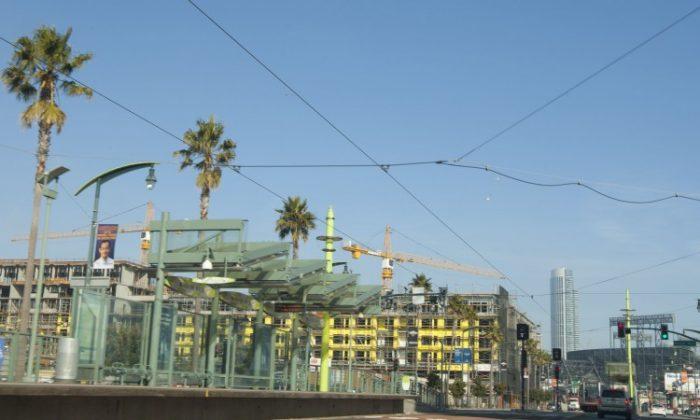SAN FRANCISCO—Walk south from Mission Bay and one can easily find ongoing construction on every other street—but while to some it’s a “success,” others are saying the development is moving “too fast.”
Sizable development plans have been in the city’s pipeline for years, but many had stalled due to economic downfall. But now “San Francisco is back,” according to Mayor Ed Lee in his State of the City Address delivered last month, and as evidence of this, he sites the numerous development projects that are finally seeing action.
The market—housing in particular—looks very attractive to developers and it’s no surprise the Mission Bay area will be seeing 4,300 housing units in the next two years.
Mission Bay is far from the half-constructed ghost town it was a few years ago, and by 2015 it will be booming, according to Catherine Reilly, acting project manager for the Mission Bay North and South Redevelopment Project.
“At the time, it was the first master plan for an area in the city of this size, and it continues to be one of the leading areas of development,” Reilly said.
Mission Bay was identified as a Priority Development Area in 1998 with plans for 6,000 housing units for various income levels; 4.4 million square feet of office, life science, and biotechnology commercial space; a new UCSF research campus and hospital complex; 500,000 square feet of retail space; a 500-room hotel; 41 acres of public open space; and other community facilities.
Blocked Off
“There’s a little frustration in the neighborhood,” said Tony Kelly, president of the Potrero Boosters Neighborhood Association. Potrero Hill looks over the water, and many of the new buildings will be “too tall,” the residents say.
Another reason for the surge of development is the Eastern Neighborhoods’ new zoning plans that have allowed for building exceptions in various areas.
One group is already petitioning against the 84-foot-tall, 700,000-square-foot Kaiser Permanente building that would add an estimated 7,700 additional visitors daily and look largely out of place at the bottom of Potrero Hill, according to some. In addition, Mission Rock’s tallest tower could be 380 feet, the two buildings at 801 Brannan and 1 Henry Adams would have a 68-foot height limit, and Mission Bay Block 40 buildings could be 180 feet tall.
In addition to too-tall buildings, a lot of the residents are concerned there won’t be enough infrastructure to support the new development and population increase, Kelly said.
Potrero Hill is highly residential, and right now is “one of the best neighborhoods in the city,” said Christine Doud, a top-producing real estate agent on Potrero Hill.
My guess is that [with more development] a lot of the folks are going to want to live in the larger complexes; they'll be looking for that high-density living,“ Doud said. ”That demographic would be more of the young professionals, a lot of them coming from outside of the city.”
Joan Bogiages, a longtime resident of Potrero Hill, said right now it feels like “a tiny village inside a city.”
“I feel very lucky to live here,” Bogiages said. “It has a very small-town kind of feel, but at the same time you’re in the middle of a big city with everything a big city has.”
“They’re going to have a community of 12,000 and turn it into 20,000. That’s going to be more traffic, more use of existing parks, more use of everything,” she added.
Some residents complained that the traffic in the area is already congested.
“If there’s a ball game, or anything major, forget it—you’re not going anywhere. I sort of resent being confined,” said Anita Synovec, Potrero Hill resident of 32 years.
Reilly says there were plans to add two MUNI lines through Mission Bay, but the roads for those buses don’t exist yet.
Many of the buildings being developed come with more open space than required, and the new parks will be maintained by the Successor Agency holding the Mission Bay Redevelopment Project so as to not tax the city’s Recreation and Parks Department.
Parks, schools, and public transportation are all scarce, said Kelly, and Potrero Hill residents have been used to picking up the tab to provide amenities for their community. Even with all the development, the city hasn’t been able to find the resources to respond to the neighbors’ requests. “Sometimes we feel so alone out here,” Kelly said.
The Recreation and Parks Department could not afford to maintain existing parks, let alone open new ones, so residents like Bogiages took it upon themselves to create and maintain “pocket parks” throughout the area.
Three out of five Potrero Hill public schools were slated for closure in 2005, and a group of parents formed PREFund to underwrite education initiatives in the neighborhood, reform their local elementary school, and create a new preschool.
Not all of the surrounding neighbors eye the rising development projects with skepticism.
Good Neighbors
The group opposing the Kaiser medical office and the residential and retail building has reached out to the Bayview-Hunters Point community in hopes of relocating the project there. While Potrero Hill will already be seeing a new UCSF medical facility, Bayview has a plot of land just as big and sees more hospitalization than any other neighborhood, according to a 2006 report from the San Francisco Department of Public Health.
Dogpatch is starting to attract development interest from outside the neighborhood as well, “really because there’s no more room in Mission Bay,” says resident Bruce Huie. And that’s not a bad thing, he says.
Huie is one of the many community members who have created self-maintained “pocket parks” throughout the area. “A lot of the development here is really driven by the community. ... It’s citizen-led neighborhood development,” he said.
“There’s a lot of underutilized space,” he added, and development could bring more collaboration with the city.
The revitalization of Pier 70, traditionally an industrial hub of shipbuilding on the eastern waterfront, is another major project.
Developer Forest City is prioritizing community involvement in the planning stage to develop a third of the pier, and what they’ve found is that residents don’t want another Mission Bay.
As a way to get to know the community’s wants, needs, and culture, Forest City hired local illustrator and graphic journalist Wendy MacNaughton, who created “Pier 70 Community in Its Own Words” last year. MacNaughton spent about a month in the area, talking to people and drawing all day long. Her graphic journalism works are drawn on site, in the moment, and paired with the community’s words.
“People basically saw their neighborhood right next door being developed in a way that they didn’t want their neighborhood being developed in. They saw it happen very fast,” MacNaughton said.
“It’s its own city,” she quoted someone saying about Mission Bay, in her graphic work.
“It’s a bunch of shoeboxes,” someone else said.
“Great research is going to come out of there.”
“But a lot of the charm was lost.”
From her various conversations and interviews, MacNaughton gathered that they felt the development of Mission Bay was too impersonal, with no sense of history or community.
MacNaughton, who lives in Potrero Hill, says “even in five years it’s changed tremendously. It’s incredible what’s happened.”
Catherine Reilly says a lot of the neighboring residents’ concerns have to do with aesthetics, which is subjective.
“Unlike some of the older areas where it was developed over 100 years and you have a hundred layers of different, changing styles and architects, and you get that finer-grained feel; with Mission Bay it’s really over a 15-year period, and you can get more of a similar feel,” Reilly said of the new and the soon-to-be Mission Bay buildings. “I think that’s what a lot of people miss—that they don’t have a 90-year-old building next to a 5-year-old one.”
“It would’ve been nice to have it develop over a hundred years, ... but it’s so successful that it’s just going quicker,” she said.
The city’s General Plan lists both improving and increasing housing, and protecting the aesthetic value of the Bay. These goals may prove to be conflicting, but aesthetic qualities are worth protecting, says San Francisco Planning Department director John Rahaim.
“I’ve come to believe that there is in fact a very special quality to this city that requires us to pay attention to the details,” Rahaim said at a SPUR event last month. The Planning Department reviews close to 2,000 project cases per year, with more projects in the city required by law to be reviewed than any other city in the country. “The texture of San Francisco exists at a scale that is seen in very few large cities in the country,” he said.
The Epoch Times publishes in 35 countries and in 21 languages. Subscribe to our e-newsletter.










Friends Read Free